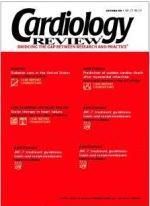Publication
Article
Cardiology Review® Online
Challenges and progress in treating chronic total coronary occlusions
Successful recanalization of chronic total coronary occlusions remains one of the major challenges for percutaneous coronary intervention (PCI). Nearly one third of patients undergoing coronary angiography have a chronic total coronary occlusion. PCI will be attempted in approximately 10% to 20% of cases. The technical considerations for PCI of these occlusions are complicated by the absence of a clear route through the true lumen and the hard calcified composition of lesions. Procedural success is often limited by inability to pass a guidewire, difficulty positioning the balloon, and inability to expand the balloon. The use of new techniques, including specialized guidewires that are stiffer or more hydrophilic and low profile balloons, has improved the short- and long-term success of PCI for chronic total coronary occlusions. Even newer advances in PCI, including laser debulking, combined intravascular ultrasound with steerable catheters, and blunt microdissection, continue to expand upon successful recanalization strategies. Even after successful recanalization, there is the remaining challenge of the high restenosis rate, reportedly up to 70% with balloon angioplasty alone.1 The use of stents, however, has lowered restenosis rates of chronic total coronary occlusions by over 50%.2
The Total Occlusion Angioplasty Study supported by Societá Italiana di Cardiologia Invasiva (TOAST-GISE), highlighted by Olivari and colleagues (page 38), attempts to provide a “real life” perspective on the current status of the treatment of chronic total coronary occlusions. The Italian multicenter study describes outcomes in 376 consecutive patients who had long-term (> 30 days) chronic total coronary occlusion. Patients with Thrombolysis in Myocardial Infarction (TIMI) flow grade 2 to 3 and a brief occlusion time were excluded, but small vessels and long lesions were included. The quality of the data analysis was excellent, with films assessed by an independent angiographic laboratory. In accordance with current practice, the investigators used a wide range of guidewires and achieved technical and procedural success in 77.2% and 73.3% of lesions, respectively. Similar to the findings of earlier studies, predictors of PCI failure were (1) lesion length greater than 15 mm (or not measurable), (2) moderate to severe calcification, (3) vessel occlusion for more than 180 days, (4) multivessel disease, and (5) unidentifiable stump morphology.
Major adverse clinical events were reasonably low at 5.1%. Non-Q-wave myocardial infarction (MI) was the most common adverse event, being detected in 16 of the 19 cases with a major adverse clinical event. There was only one early death from a pulmonary embolus. At 1-year follow-up, cardiac mortality, non—Q-wave MI, and coronary artery bypass graft surgery, though uncommon, were significantly lower in those patients with successful PCI of the occlusion. Clinically, patients who had a successful revascularization were more likely to be free of angina (88.7% versus 75%) and were more likely to have a “negative” treadmill stress test (73% versus 46.7%) compared with those who were not successfully revascularized.
Despite the high-quality techniques used in the study, TOAST-GISE only gives us a partial “real world” view of the treatment of chronic total coronary occlusions. The restenosis rates are unknown because follow-up catheterization was not performed routinely. Although it is the largest study of chronic total coronary occlusions to date, it was not powered to assess clinical outcomes. With the small study cohort and low event rate, a shift of only one or two events could change the statistical significance of several end points. Although major adverse clinical events were uncommon, troponin measurements were not obtained, resulting in underestimation of periprocedural infarctions. Small non—Q-wave MIs may be much more common, especially in the setting of chronic total coronary occlusion, where there can be a high risk of distal embolization.
The patient population in TOAST-GISE was not typical of American catheterization populations, in which a majority of patients present with acute coronary syndromes. Seventy percent of the TOAST-GISE Italian patients had stable angina, and only 17.5% had unstable angina. Given this high incidence of angina, it is not surprising that successful recanalization of chronic total coronary occlusions led to less chest pain and improved stress test results, even if restenosis rates might have been high. Additionally, the technical approach in this study did not mirror current US interventional practice. Only 76 of 376 patients underwent multivessel stenting, and only 10.4% received glycoprotein (GP) IIb/IIIa receptor blockers. Despite the high incidence of previous MI, ejection fractions were high (mean 55.9%), and most patients had normal or partially preserved wall motion in the region subserved by the chronic total coronary occlusion vessel, suggesting a high incidence of viable muscle.
Conclusions
What can we conclude about the current approach to chronic total coronary occlusion? The results of TOAST-GISE and recent clinical studies emphasize the increased success of PCI in patients with chronic total coronary occlusion.3,4 New techniques can achieve a remarkably high rate of reperfusion. The study showed that this can be achieved even without routine use of GP IIb/IIIa receptor blockers. Long-term outcomes indicate PCI treatment is beneficial in patients with clinical evidence of ischemia. It is hoped that outcomes will improve even further as revascularization methods improve using intravascular ultrasound to assess stent placement and implantation of drug-eluting stents. What is not fully answered is the risk/benefit ratio of treating patients at high risk, such as those with a low ejection fraction and multivessel disease. TOAST-GISE supports the “open artery hypothesis,” but only for those patients with either preserved wall motion, ischemic symptoms, or both. A large, randomized trial is needed to determine the importance of viability in segments beyond chronic total coronary occlusions and the proper selection of patients who can benefit from PCI in this setting.
